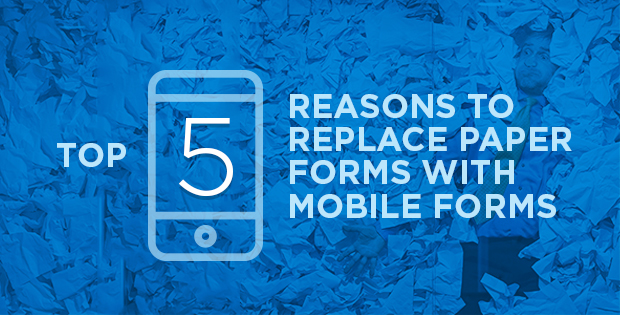
For years, paper forms were the way for enterprises and SMBs to collect data in the field. While limited in capability, alternatives to paper forms were either unavailable or too expensive. However, with the advent of smartphones and tablets, mobile forms have now emerged as a more productive, more efficient in-the-field option
Here are the top five reasons to replace paper forms with mobile forms:
1. Errors
For the most part, paper forms are filled in by hand, increasing the likelihood of human error. Paper forms take a long time to complete, contain illegible handwriting, incorrect calculations, missed form fields, and are difficult to secure in inclement conditions. One of the most common ways companies waste time is in manual data entry. Rather than having an office employee pour over submitted paper forms and try to decipher handwriting from the field, using mobile forms, companies can automatically update spreadsheets with pre-submitted data, and data from the field can be submitted at the click of a button, virtually eliminating errors.
2. Hidden Costs
Paper forms hold many hidden costs. Printing, transporting, and storage costs all add up, not to mention time compiling, managing, and analyzing information can prove cumbersome and costly. With mobile forms, field workers have the ability to instantly upload data. Colleagues in other locations are immediately able to access the information for ease in collaboration and reduced time and cost.
3. Difficult to Access Data
We’ve been conditioned as consumers to demand instant access to data. Unlike mobile forms, paper forms cannot be transferred to manager or co-workers and entered into a back office system instantly. Mobile workers must search for a fax machine, or in some cases, drive the paper forms back to the office for transcribing and filing. When it comes time for an audit, or data is required again, it must be fished out of a filing system or storage place. With mobile forms, you are granted instant access to your data, and no rifling through filing cabinets!

4. No Rich Data
A paper form has a standard printed framework. Conversely, mobile forms have several options that can immensely improve an enterprise’s workflow. With mobile forms, you are able to collect photos, signatures, scan barcodes, GPS and time stamp, record audio, and more. These can all be entered seamlessly into a mobile form and sent directly to a back office or configured to send to a specific place in the format of your choice.
5. No Actionable Data
You can’t manage what you don’t track. Mobile forms allow you to get reports and analyze data from the field to uncover patterns, meaningful correlations, and the root cause of critical issues. Being able to not just access, but actually use your data to respond to an audit, in a way that you can demonstrate to customers, partners, or regulatory officials that you are compliant using dashboards is miles ahead of what paper can do for you. Sometimes having that paper in a filing cabinet doesn’t make it the easiest way to get that data to the key stakeholders.
Want to learn more? Request a demo and start your free trial!




